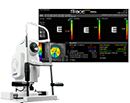How The iTrace Makes Life Easier
for One Leading MD
Meet Mitchell C. Shultz, MD

Having trained under some of the world’s top specialists as well as being involved with numerous cutting-edge clinical trials, he had some interesting insights about his experience using the iTrace and the impact it’s had on his practice and his patients.
Here’s what he told us:
“The iTrace Makes My Life Easier Every Day”
During our conversation with Dr. Shultz, he told us in the 8 years since he purchased the device, he’s made the iTrace one of the most heavily used tools in his practice.
As his team began to develop a deeper understanding of multifocality and line of sight, they started looking for a tool that could provide more in-depth reports on his patients’ vision. He landed on the iTrace because, in his words, “it gave me everything I needed.”
Here are three reasons why Dr. Shultz feels that the iTrace is an invaluable part of his practice:
The iTrace Makes His Practice More Flexible
Dr. Shultz reported that the device’s user-friendly operation has made it easy to train his technicians to run the scans on patients in the lane, equipping him to be more efficient with his time in the exam room.
Since iTrace data exports directly into the EMR system, he can sit down with a patient when they get into the exam room, pull up their scans on his tablet, and show them exactly what’s going on with their vision.
He also said that the iTrace’s image quality is so high that he uses images from iTrace scans in the operating room to reference during surgeries.

The iTrace Makes it Easier to Communicate with Patients
Dr. Shultz has made this tool part of a typical exam for a large subsection of his patient population: “I use the iTrace on pretty much every patient who comes in for a vision correction evaluation (cataract and refractive), as well as inexplicable vision issues.”
His patients love seeing the latest technology and they value demonstrations using the iTrace’s key outputs. For example, he uses the Dysfunctional Lens Index (DLI) feature to show patients an objective simulation of their potential quality of vision after lens replacement.
As Dr. Shultz puts it, “being able to show patients what their vision will look like corrected is a powerful tool.”
The iTrace Empowers a Comprehensive Approach to Lens-Based Procedures
The iTrace is the only device on the market that makes it easy to plan, execute, and confirm the placement of the IOL.
Before surgery, Dr. Shultz uses iTrace data to choose the right IOL in a given case. Since the slightest variation in measurement can make a major difference in post-op vision quality, the iTrace is the only tool many doctors trust when doing this.
During surgery, he uses iTrace data to add precision to the lens implant process. For example, in patients with severe hyperopia, the center of the eye can vary from the center of the lens capsule. The iTrace’s Angle Alpha measurement predicts when a multifocal will not align well with the visual axis, enabling him to choose the right lens for the right patient adding precision and improving the process management.
After surgery, the iTrace does something no other tool can. The iTrace’s Toric Check feature allows doctors to measure the power and the exact angle of toric lens alignment — without needing to dilate. He says this has been one of the biggest benefits of the adopting the iTrace:
“Before we had the Toric Check, we were dilating patients, which was taking time — and you can’t always get them dilated properly to see the lens. The beauty of the Toric Check is that we no longer have to dilate and we can still see where the lens is.”

What You’re Missing When You Don’t Have the iTrace
Between an improvement in patient communication, an increase in practice efficiency, and a more precise approach to surgery, it’s easy to see why Dr. Shultz and surgeons value the iTrace’s ability to support them in their mission to provide better clinical outcomes and creating happier patients as a result.
Ready to see the iTrace in action for yourself? Contact us to schedule a demo.

